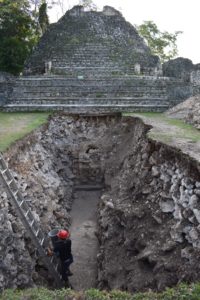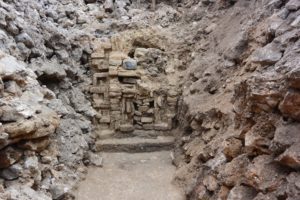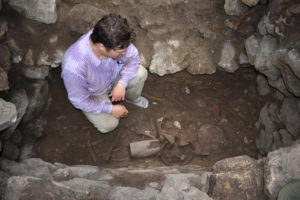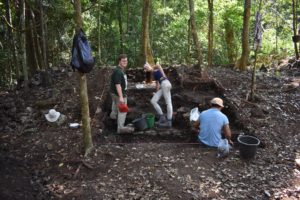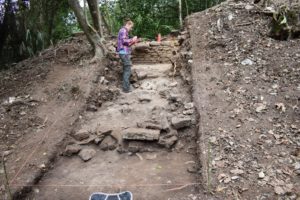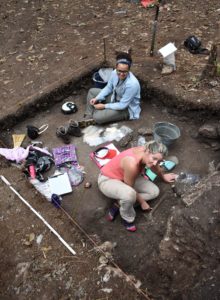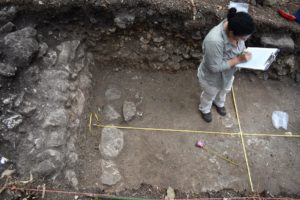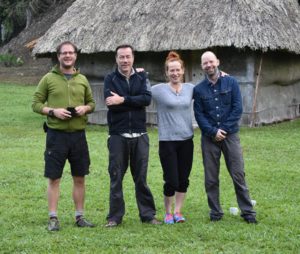This was a very busy week with things starting to “pop” in the field. Perhaps the most important thing to happen is that the plaza trench in Caana is finally at the stage where we are ready to begin floor penetration on axis to Structure B20 across the lower buried plaza surface. Excavation C1K is now over 4 m below the current plaza surface – and the original stair mask for Structure B20 is once again visible after 31 years. One interesting artifact recovered in the fill for the upper floor were pieces of stucco that formed the glyph for “5 Ahau” and that must have once graced the cornice of an earlier Caana building. On Friday the lowest step for the original Structure B20 was removed in front of the mask and we are now ready to begin systematically removing lower plaza floors on Monday.
A lot also happened in Rebel during the week. In C210B, the infilled tomb that had been intruded through the earlier stair was largely excavated and the first plan was drawn. There appear to be at least 7 vessels and 3 bodies on the floor of the chamber under the fill. On the summit of this eastern building, a series of caches were recovered in the upper fill. The first one appeared in the rear of the building and was a repurposed Early Classic painted cylinder (with 3 human figures and a sun god handle on the lid) associated with animal bone and a jadeite bead. The second one was a large face cache with modeled nose and mouth and white-painted eyes and hood associated with two obsidian cores, a stingray spine, a jadeite ball, a jadeite chip, and river snails. To the front summit of the building core was a burnt area with limestone bars and a jadeite bead above small bone fragments (human?); in the back of the building summit, in burnt soil, another 18 limestone bars were recovered (plus 2 more in subsequent excavation). Also in the rear core of the building was a half-sectioned crypt containing a few bone fragments and an obsidian eccentric; a fluted bowl and part of a Belize Red cylinder were located in the area from which the crypt had been removed. There were also badly broken finger bowls strewn throughout the upper summit fill, none of which fully were reconstructable. Finally, under the upper black summit soil and large rubble was a cobble layer that began producing a large amount of lithic chips at noon on Saturday. Excavations also continued in C210C this week, producing an east-west facing (looking north) in the rear fill of the building, under which was a plaster floor that was also cut in an east-west pattern. The front of C210C produced the outlines of a stairbalk, so the excavation was extended south 1 m by 3 m to better define the building front.
In Rogue, the northern stone building, Excavation C211C, was largely cleared down to its floors and architecture – and the real front stair was finally located in the plaza. The plan of the architecture was drawn. There is not a good plaza surface in front of this building, but rather large fill stones. In C211B, the eastern building in Rogue, two burials were found and excavated this week. The first was a child placed in a supine position directly on the buried floor of an earlier building with head to the south and accompanied by a necklace of spondylus beads. The second was an adult male placed face down to the south with legs flexed and located under the first stair of the building; he was accompanied a set of circular carved conch earrings. On the summit, there is a crude facing outside the building on the slope of the hill. A formal facing from the building is located a short distance in front of the construction surface; about a half meter west of the first building facing was another buried rear facing for the building that articulated with the buried floor upon which the child had been set. This floor rests on a cobble fill that disappeared at its western extent into an all-dirt brown fill (that would have been beneath the upper part of the frontal stairway). We hope to excavated more of the core of this building next week.
Also this week, we were graced with a 4-person German film crew who were preparing a PBS-type program on research in the broader Caribbean for a show called “Terra X” which has an audience of over 5 million in Germany and France. They should have gotten very good footage and we look forward to seeing their final product.
Four meters down to the early Caana plaza surface
Structure B20 basal mask on earlier plaza surface
Adrian in infilled tomb in C210B
Polychrome cylinder tripod with 3 figures and lid
Ben, Jessica, and Rob in C210C
Kelsey drawing the plan of C211C
Amy and Olyvia excavating the step burial in C211B
Melissa drawing plan in C211B summit
Terra X film crew: Florian Huber, Chritopher Gerisch, Katherine Butzke, Oliver Gurr
